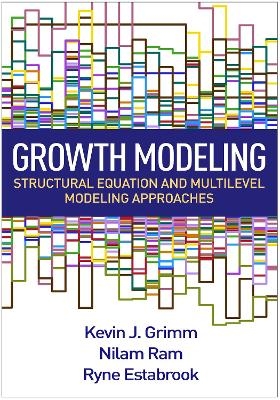
Growth Modeling
Guilford Press (Verlag)
978-1-4625-2606-2 (ISBN)
- Titel z.Zt. nicht lieferbar
- Versandkostenfrei innerhalb Deutschlands
- Auch auf Rechnung
- Verfügbarkeit in der Filiale vor Ort prüfen
- Artikel merken
User-Friendly Features
*Real, worked-through longitudinal data examples serving as illustrations in each chapter.
*Script boxes that provide code for fitting the models to example data and facilitate application to the reader's own data.
*"Important Considerations" sections offering caveats, warnings, and recommendations for the use of specific models.
*Companion website supplying datasets and syntax for the book's examples, along with additional code in SAS/R for linear mixed-effects modeling.
Winner--Barbara Byrne Book Award from the Society of Multivariate Experimental Psychology
Kevin J. Grimm, PhD, is Professor in the Department of Psychology at Arizona State University, where he teaches graduate courses on quantitative methods. His research interests include longitudinal methodology, exploratory data analysis, and data integration, especially the integration of longitudinal studies. His recent research has focused on nonlinearity in growth models, growth mixture models, extensions of latent change score models, and approaches for analyzing change with limited dependent variables. Dr. Grimm organizes the American Psychological Association’s Advanced Training Institute on Structural Equation Modeling in Longitudinal Research and has lectured at the workshop for over 15 years. Nilam Ram, PhD, is Professor in the Departments of Communication and Psychology at Stanford University. He specializes in longitudinal research methodology and lifespan development, with a focus on how multivariate time-series and growth curve modeling approaches can contribute to our understanding of behavioral change. He uses a wide variety of longitudinal models to examine changes in human behavior at multiple levels and across multiple time scales. Coupling the theory and method with data collected using mobile technologies, Dr. Ram is integrating process-oriented analytical paradigms with data visualization, gaming, experience sampling, and the delivery of individualized interventions/treatment. Ryne Estabrook, PhD, is Assistant Professor in the Department of Medical Social Sciences at Northwestern University. His research combines multivariate longitudinal methodology, open-source statistical software, and lifespan development. His methodological work pertains to developing new methods for the study of change and incorporating longitudinal and dynamic information into measurement. Dr. Estabrook is a developer of OpenMx, an open-source statistical software package for structural equation modeling and general linear algebra. He applies his methodological and statistical research to the study of lifespan development, including work on early childhood behavior and personality in late life.
I. Introduction and Organization
1. Overview, Goals of Longitudinal Research, and Historical Developments
Overview
Five Rationales for Longitudinal Research
Historical Development of Growth Models
Modeling Frameworks and Programs
2. Practical Preliminaries: Things to Do before Fitting Growth Models
Data Structures
Longitudinal Plots
Data Screening
Longitudinal Measurement
Time Metrics
Change Hypotheses
Incomplete Data
Moving Forward
II. The Linear Growth Model and Its Extensions
3. Linear Growth Models
Multilevel Modeling Framework
Multilevel Modeling Implementation
Structural Equation Modeling Framework
Structural Equation Modeling Implementation
Important Considerations
Moving Forward
4. Continuous Time Metrics
Multilevel Modeling Framework
Multilevel Modeling Implementation
Structural Equation Modeling Framework
Structural Equation Modeling Implementation
Important Considerations
Moving Forward
5. Linear Growth Models with Time-Invariant Covariates
Multilevel Model Framework
Multilevel Modeling Implementation
Structural Equation Modeling Framework
Structural Equation Modeling Implementation
Important Considerations
Moving Forward
6. Multiple-Group Growth Modeling
Multilevel Modeling Framework
Multilevel Modeling Implementation
Structural Equation Modeling Framework
Structural Equation Modeling Implementation
Important Considerations
Moving Forward
7. Growth Mixture Modeling
Multilevel Modeling Framework
Multilevel Modeling Implementation
Structural Equation Modeling Framework
Structural Equation Modeling Implementation
Model Fit, Model Comparison, and Class Enumeration
Important Considerations
Moving Forward
8. Multivariate Growth Models and Dynamic Predictors
Multilevel Modeling Framework
Multilevel Modeling Implementation
Structural Equation Modeling Framework
Structural Equation Modeling Implementation
Important Considerations
Moving Forward
III. Nonlinearity in Growth Modeling
9. Introduction to Nonlinearity
Organization for Nonlinear Change Models
Moving Forward
10. Growth Models with Nonlinearity in Time
Multilevel Modeling Framework
Multilevel Modeling Implementation
Structural Equation Modeling Framework
Structural Equation Modeling Implementation
Important Considerations
Moving Forward
11. Growth Models with Nonlinearity in Parameters
Multilevel Modeling Framework
Multilevel Modeling Implementation
Structural Equation Modeling Framework
Structural Equation Modeling Implementation
Important Considerations
Moving Forward
12. Growth Models with Nonlinearity in Random Coefficients
Multilevel Modeling Framework
Multilevel Modeling Implementation
Structural Equation Modeling Framework
Structural Equation Modeling Implementation
Important Considerations
Moving Forward
IV. Modeling Change with Latent Entities
13. Modeling Change with Ordinal Outcomes
Dichotomous Outcomes
Polytomous Outcomes
Illustration
Multilevel Modeling Implementation
Structural Equation Modeling Implementation
Important Considerations
Moving Forward
14. Modeling Change with Latent Variables Measured by Continuous Indicators
Common-Factor Model
Factorial Invariance over Time
Second-Order Growth Model
Illustration
Structural Equation Modeling Implementation
Important Considerations
Moving Forward
15. Modeling Change with Latent Variables Measured by Ordinal Indicators
Item Response Modeling
Second-Order Growth Model
Illustration
Important Considerations
Moving Forward
V. Latent Change Scores as a Framework for Studying Change
16. Introduction to Latent Change Score Modeling
General Model Specification
Models of Change
Illustration
Structural Equation Modeling Implementation
Important Considerations
Moving Forward
17. Multivariate Latent Change Score Models
Autoregressive Cross-Lag Model
Multivariate Growth Model
Multivariate Latent Change Score Model
Illustration
Structural Equation Modeling Implementation
Important Considerations
Moving Forward
18. Rate-of-Change Estimates in Nonlinear Growth Models
Growth Rate Models
Latent Change Score Models
Illustration
Multilevel Modeling Implementation
Structural Equation Modeling Implementation
Important Considerations
Appendix A. A Brief Introduction to Multilevel Modeling
Illustrative Example
Multilevel Modeling and Longitudinal Data
Appendix B. A Brief Introduction to Structural Equation Modeling
Illustrative Example
Structural Equation Modeling and Longitudinal Data
References
Author Index
Subject Index
About the Authors
| Erscheinungsdatum | 13.10.2016 |
|---|---|
| Reihe/Serie | Methodology in the Social Sciences |
| Verlagsort | New York |
| Sprache | englisch |
| Maße | 178 x 254 mm |
| Gewicht | 1123 g |
| Themenwelt | Geisteswissenschaften ► Psychologie ► Entwicklungspsychologie |
| Medizin / Pharmazie ► Pflege | |
| Sozialwissenschaften ► Pädagogik | |
| Sozialwissenschaften ► Soziologie | |
| Wirtschaft ► Volkswirtschaftslehre ► Ökonometrie | |
| ISBN-10 | 1-4625-2606-3 / 1462526063 |
| ISBN-13 | 978-1-4625-2606-2 / 9781462526062 |
| Zustand | Neuware |
| Haben Sie eine Frage zum Produkt? |
aus dem Bereich


